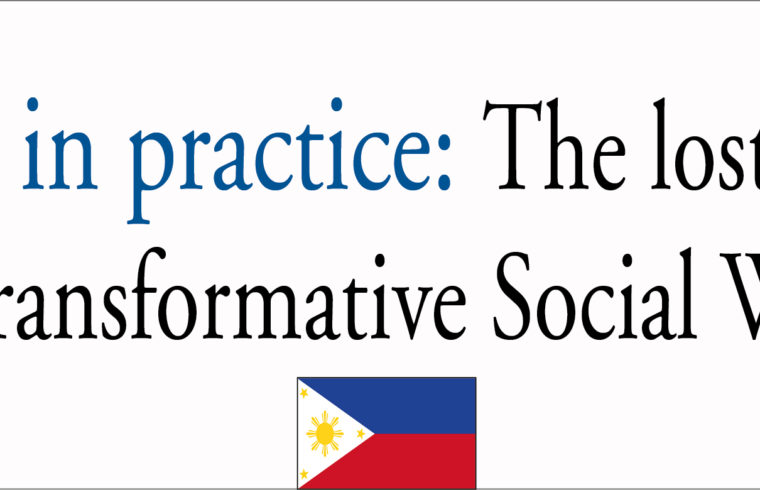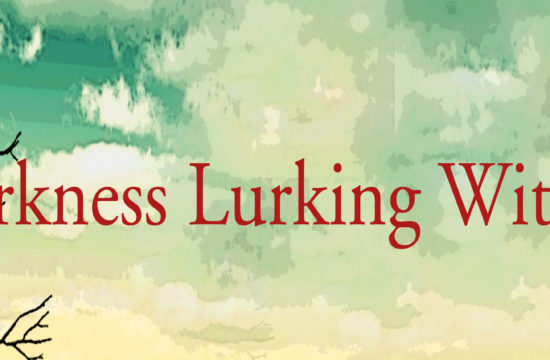Justin Francis Leon V. Nicolas
University of the Philippines Diliman
In the Philippines, social workers find themselves in what Linda Briskman (2013; 2014; Briskman & Zion, 2014) calls the ‘dual loyalty conundrum’. Fergusson and Lavalette (2013) explain Briskman argues that ‘it is possible for workers to navigate through the competing pressures they face to develop radical and critical practice’ (p. 12). Social workers, employed by the State welfare agency (Department of Social Welfare and Development) and by local social development and welfare offices (LSWDO), are bound to follow civil service regulations and therefore find themselves in ethical dilemmas between loyalty to agency or fulfi lling one’s call to protect and serve the needy. Just recently, former DSWD offi cial and social worker Florita Villar expressed concerns that the state welfare agency is now being run by nonsocial workers and even worse, former military personnel appointed by the president. This move of the current president Rodrigo Duterte attempts to rid the bureaucracy of militants and radical employees who question the repressive practices in government. Social workers, who would rather protect their careers, become workers of the welfare agency that has become an instrument of a repressive state apparatus. Social Workers Educators are not free from this conundrum and they may also find themselves in such situations especially those employed by more conservative universities and those limited by policies of state universities.
At the University of the Philippines College of Social Work and Community Development (UP-CSWCD), the Department of Social Work (DSW), through a series of planning workshops conducted more than a decade ago, identifi ed its brand of scholarship as “transformative social work” which combined community engaged teaching, service and research (UP-CSWCD 2011 Strategic Planning documents). Departing from Boyer’s dimensions of scholarship in the 1990s (discovery, integration, application, teaching, and engagement), the department further aimed at theorizing a Filipino brand social work informed by indigenous and local practices in response to the need to bridge the gap between practice and instruction. This meant reaching out to practitioners in different fields across the regions in the country to scan existing social work practices.
In 2016, the entry of the Duterte administration marked a new era in social welfare and development. With thousands of citizens murdered in extra- judicial killings (EJK) related to the Duterte administration campaign against drugs, there was a clamor to revisit the commitment of social workers in relation to human rights and social justice. The main organization of social workers in the Philippines (PASWI) and other social worker formations were mostly silent on issues related to the excessive use of power by government. As such, in August 2020, during the pandemic, a group of social workers formed the Social Work Action Network (SWAN) Philippines to revive the commitment of social workers to human rights by promoting critical practice, liberative education and social justice in an eco-social world. In short, it redefined transformative social work by extending a community-engaged scholarship to a more critical and progressive stance in practice that works for structural transformation and fundamental change (George and Marlowe, 2005). However, I argue that there is still that lost ingredient in social work practice. A liberative education in the context of transformative social work should combine critical thinking with refl exive and creative thinking.
Referring to Education as a whole, Ken Robinson (2011) argued that “Current systems of education were not designed to meet the challenges we now face. They were developed to meet the former age. Reform is not enough; they need to be transformed”. Ken Robinson was referring to the need to re-learn creativity in schools. According to Hafford -Litchfi eld, Leonard and Coachman (2012), creative styles in social work teaching develop the students for “creativity and readiness to break new ground” (p.684) and such an approach to social work education has that “transformative potential” (p.684). Putting these ideas together, the following are propositions in revising the notion of transformative social work:
1. Transformative social work requires a transformative social work education.
2. Transformative education maximises its transformative potential by combining critical thinking and creative thinking.
3. Critical thinking and creative thinking produce innovative ways on how to shape a liberative education and critical-creative practice in social work.
In short, creativity remains to be the long-lost ingredient in social work practice. Lydia Rapoport (1968) argued that as social work was initiated to a professional subculture, the once creativity-laden practice has been consumed by standardization and professionalization. In the Philippines, the Department of Social Work revised its Social Work curriculum in 2018 to include a course on critical social work at the undergraduate level and Models of Practice at the graduate level. Although critical social work has been discussed in other subjects, there was a need to discuss spectrum perspectives and models of transformative social work, which include critical social work, radical social work, structural social work, anti-oppressive social work, as well as gender-sensitive, inclusive and green social work.
espite human rights being an integral part of social work as the foundation of inherent human dignity and worth, teaching human rights is not explicitly part of the social work curriculum. Purposive discussion of human rights may have been taken for granted in many social work educational settings. Briskman (2014) laments of her ordeal as a social activist having witnessed the infringement of rights among the most vulnerable and yet, still received negative responses from the government which pushed her to call for the “ascendancy of the moral practitioner” (p. 301). In the Philippines, human defenders have been harassed and red-tagged or considered communists or even terrorists. As Berta Reynolds (1946) commented, social work cannot advance theoretically if it will have a purpose other than helping the people in need. If social workers become instruments of the state apparatus and social work is forced not to fulfi l its real mandate of helping people emancipate themselves from the chains of poverty and oppression, then it ceases fulfi lling its original function of promoting human dignity and worth through just social relations and empowerment of the vulnerable and at risk. As such, the UP faculty of social work has proposed through the Commission on Higher Education (CHED) that human rights be incorporated in the teaching of all social work subjects. This proposal has yet to be realised. In the meantime, social worker members of the SWAN Philippines conducted a workshop in September 2021 that brought together social work educators, practitioners and students to discuss Social Work as a human rights profession and learn new ways of re-introducing human rightsbased approaches in teaching and practicing social work.
In conclusion, this introductory text calls for allowing creativity to progress back into our ranks and include it as one of the values of social work. The social work community has yet to understand the philosophy of creativity in social work and how creativity harnesses innovative and transformative social work education and practice. Several social work writers have emphasized the generative potential of creativity in creative pedagogy and transformative education (Burgess, 2004; Nicolas, 2019; Rapoport, 1968; Walz & Uematsu, 1997). These writers have argued the need for a creative curriculum, a creative pedagogy, and a creative milieu. The world has witnessed the value of creativity in the time of COVID-19, how social workers responded to volatility and uncertainty. Creativity is not limited to applying the creative arts in social work. It involves pushing boundaries and knowledge creation in social work (Nicolas, 2016). Creativity is radical, not bound by a standard set of rules and therefore an important component of transformative social work.
References
Boyer, Ernest (1990). Scholarship Reconsidered: Priorities of the Professoriate. Menlo Park, CA, The Carnegie Foundation for the Advancement of Teaching: 147.
Boyer, Ernest (1996). ‘The Scholarship of Engagement’, Journal of Public Outreach, 1(1): 11-20.
Briskman, L. (2013). Courageous ethnographers or agents of the state: challenges for social work. Critical and Radical Social Work, 1(1), pp, 51-66. Policy Press. https://doi.org/10.1332/204986013X665956
Briskman, L. (2014). Refl ections of an activist social worker: challenging human rights violations. In Noble, C., Strauss H., & Littlechild, B. (Eds), Global Social Work: Crossing borders, blurring boundaries (pp. 301-310). Sydney University Press. https://doi.org/10.2307/j.ctv1fxm2q.25
Briskman, L. & Zion, D. (2014). Dual Loyalties and Impossible Dilemmas: Health care in Immigration Detention. Public Health Ethics, 7(3), 277–286, https://doi.org/10.1093/phe/phu024
Burgess, H. (2004). Redesigning the curriculum for social work education: Complexity, conformity, chaos, creativity, collaboration? Social
Work Education, 23(2), 163-183. doi: 10.1080/0261547042000209189
Fergusson, I., & Lavalette, M. (2013). Critical social work: An Introduction. Critical and Radical Social Work, 1(1), pp. 3-14. Policy Press. DOI: https://doi.org/10.1332/204986013X665938
George, P., & Marlowe, S. (2005). Structural social work in action. Journal of Progressive Human Services, 16(1), pp. 5-24. DOI: 10.1300/ J059v16n01_02 Haff ord-Letchfield, T., Couchman, W., & Leonard, K. (2012). ‘Arts and Extremely Dangerous’: Critical Commentary on the Arts in Social Work Education. Social Work Education, 31(6), pp. 683-690.
Nicolas, J. F. L. V. (2016). Pushing the boundaries in social work:
Establishing the place of creativity in disciplinary knowledge creation.
Humanity Journal, 7(1) 45-64.
Nicolas, J. F. L. V. (2019). Articulating creativity in social work practice. (PhD Thesis) University of Newcastle NSW Australia.
Rapoport, L. (1968). Creativity in social work. Smith College Studies in Social Work, 38(3), 139-161. doi: 10.1080/00377316809516365
Robinson, K. (2011). Out of minds: Learning to be creative. West Sussex: Capstone.
Walz, T., & Uematsu, M. (1997). Creativity in social work practice. Journal of Teaching in Social Work, 15(1-2), 17-31. doi: 10.1300/J067v15n01_03











